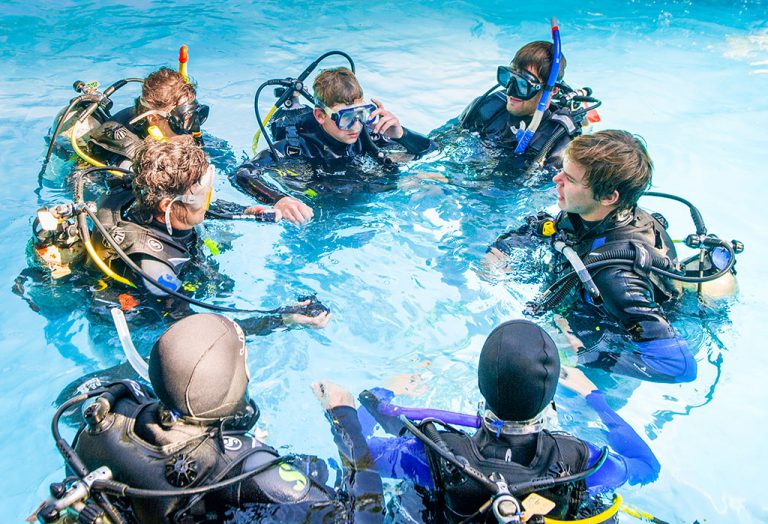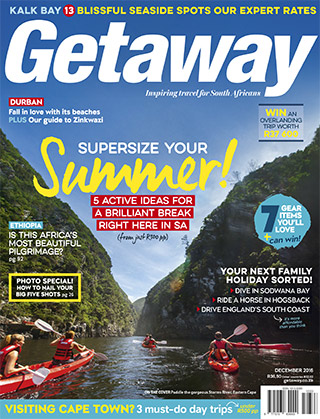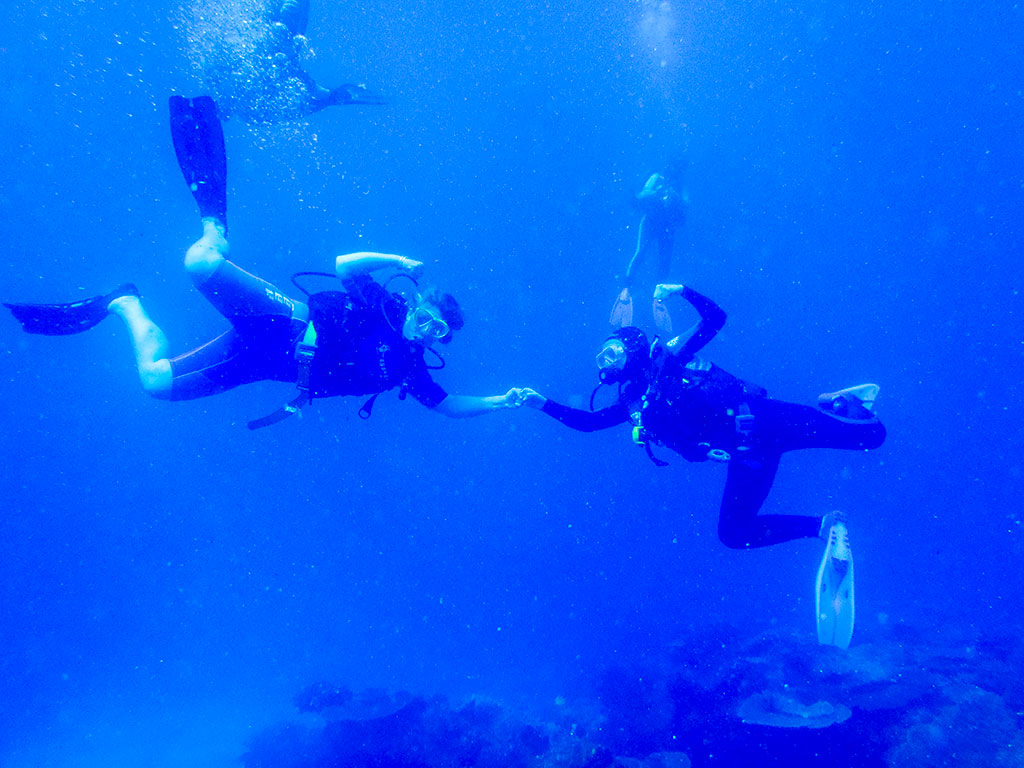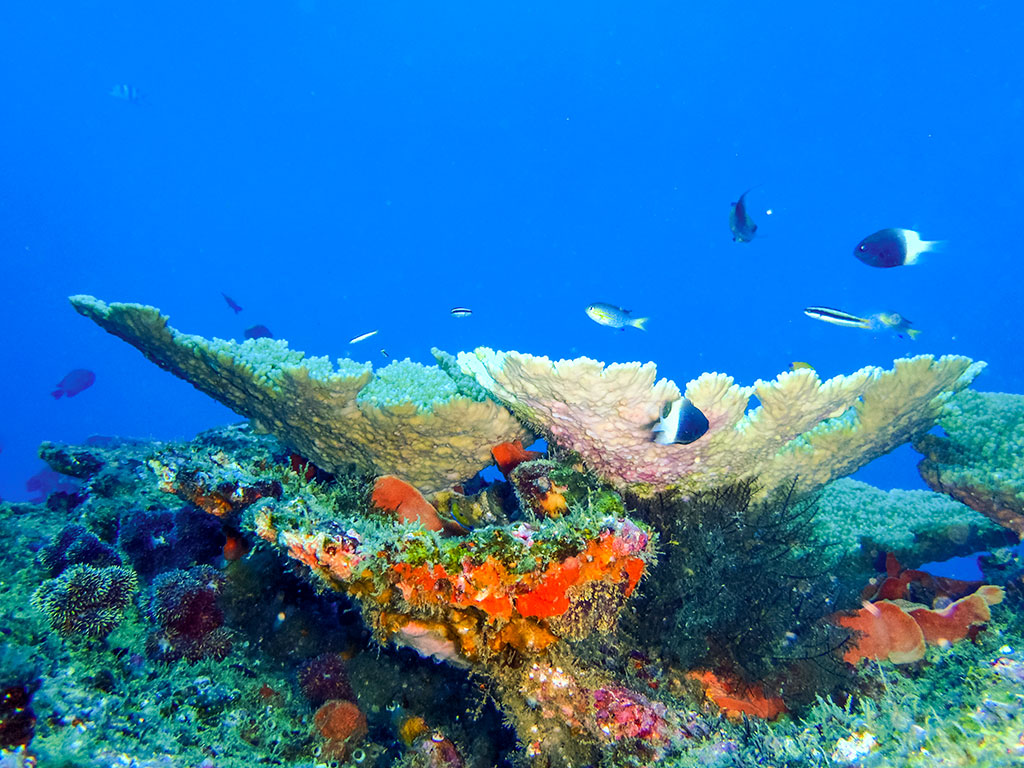It was winter in the Cape and we were yearning for warm water, sunshine and adventure – the three ingredients of our happiest family holidays.

Liam and Dane Rogers under water.
So we flew to Durban, hired a vehicle and drove up to South Africa’s tropical northeastern corner. Initially our plan was to take in the game reserves and beaches but in the back of my mind I had a different idea – the signs to Sodwana reminded me that we were near the diving centre of South Africa, and it would be a great opportunity to get Liam (12) and Dane (10) qualified and to have an unforgettable adventure.
Also read:
Sodwana Bay is within iSimangaliso Wetland Park – South Africa’s first World Heritage Site that includes a rich patch-work of lakes, grasslands, coastal forests and marine reserves that extend all the way from Kosi Bay on the border of Mozambique to St Lucia and the Eastern Shores. This area includes the country’s most southerly and best protected coral reefs, and most new divers in SA blow their first bubbles at Two Mile Reef – progressing to the more pristine Five Mile, Seven, Eight and Nine Mile reefs.
Also read: why iSimangaliso is South Africa’s most adventurous park
The largest and most established diving school in Sodwana Bay is Coral Divers, which is a PADI five-star Instructor Development Centre and Gold Palm resort. It’s inside the coastal reserve and is just two kilometres from the beach. From the moment we arrived and I saw the sign ‘We didn’t know we were making memories – just knew we were having fun’, I knew we had come to the right place for our father-and-son experience.
Coral Divers is set deep in a forest populated with chattering vervet monkeys and shy red duiker. It had a super-chilled island vibe, with people milling around, cooking, studying fish charts, sipping beers and listening to music. The safari dome tents, part of our package deal, are cheek-to-cheek with the communal showers, but we upgraded to a cabin with a balcony and an en-suite shower. We could also have set up our own tent in the KZN Parks campsite, which is a short walk away.

Student divers at a pool session
There are rows of individual fridges, pots, pans and plates to feed a small army, as well as a restaurant offering burgers and chips, milkshakes and other meals for the bevy of hungry divers. Being a dop en tjop kind of guy, I loved the communal braai fires, and rubbed shoulders and stories with a kind-hearted dive instructor called Jan (he’d shown hundreds of underprivileged kids the beauty of the reefs), an economics professor from Bloemfontein and other young families bound by their love of being underwater.
At dive planning on the first evening, we handed the lives of our young boys into the care of a fresh-faced instructor named Johnny Forbes. He was just
19 and our boys liked him immediately. ‘You will never forget where you took your first breath under water,’ he told the group.
The other six students included mothers and daughters, fathers and sons. It was heart-warming to see how they would all help one another in the challenging days that followed and the bonds that would be forged. The success of this course for our boys was the relationship they developed with the fun-loving, young instructors, who joked and teased but always stressed the seriousness of safety and discipline. Johnny insisted that every time the boys didn’t clean their O-rings, they had to buy him a milkshake.

Coral Diver’s cabins and facilities are tucked into the forest at Sodwana Bay Nature Reserve
PADI has a very organised and interesting curriculum which includes videos, lectures, pool sessions and open-water dives. The learning is reinforced with multiple-choice questions and students need 75 per cent and above to pass. There is a lot to cover and classes sometimes run until late. ‘All the important stuff that I learnt, except signs, was in the pool,’ reflected Liam as he emerged late one afternoon from the water. ‘The lectures were necessary but not as important as the confined water dives. We learnt how to gear up, how to buddy breathe, about buoyancy, being aerodynamic, what to do in life-threatening situations. Also very important things like staying away from the propeller, even if it’s obvious.’
I have my diving qualifications and figured that the best way to help the dive masters teach the boys was to stay right out of it and provide moral support where needed. On the third day, they set off to Two Mile Reef for their first open-water dive, and I waited anxiously on the shore to hear how they had gotten on. An hour later they were back with smiles as wide and bright as the beach.

Divers experience the colourful coral reefs at Sodwana Bay
‘It felt like a lifetime experience,’ said Dane. ‘I was a bit worried about being sick but it was fine. It’s amazing how tame fish are when you are underwater. They brushed against us. They really did not care about us.’
‘It felt different and amazing,’ said Liam. ‘I’ve always loved fishing but seeing them underwater doing their own thing is better than seeing them on the rocks.’
We celebrated with Johnny and the rest of the group at the nearby Mseni Lodge with prego rolls and chocolate brownies. It is a spot in Sodwana with a view of the sea, and a short walk leads to a private and secure beach which was one of the most spectacular I have seen anywhere. Although I have done hundreds of dives myself, I was celebrating the resilience that the boys had shown and their new-found passion for the underwater world that I love.
I watched them grow in confidence with this new skill and was so proud to be able to go on my first dive with them and share their excitement. Now I am planning trips to the Maldives, the wrecks of the Red Sea and other exciting places. And being a new ‘diving family’, we hope to be back at Coral Divers too, and Sodwana tjop-tjop.
After all, as Johnny said, you really never forget where you took your first breath underwater.
Plan your trip:
Getting there
We flew to Durban’s King Shaka Airport with Kulula for R1800 return. From there it’s about a four-hour drive to Sodwana Bay.
Need to know
The PADI Open Water Diver course is for ages 10 and over. The course, which allows you to dive to 18m (12m for juniors), comprises five theory and five pool sessions, an exam and four qualifying open-water dives. We went in the middle of the June school holidays and were able to find last-minute accommodation but summer holidays are likely to be a different story.
Cost
The course at Coral Divers costs R4000 per person which includes hiring all the diving gear, diving tuition and five nights in tented accommodation. The safari dome tents are basic and exclude bedding but if you are travelling light linen can be provided at R100 per person refundable deposit. However, there are also opportunities to upgrade to other facilities.
Do this
Take a night tour to see the turtles. From November to February, leatherbacks and loggerheads clamber out of the ocean to lay their eggs here on the same beaches where they were hatched decades before. Tours can be organised through Coral Divers for R750 per person, including snacks and drinks. 0333456531. Sodwana Bay is only part of the expansive and exciting iSimangaliso Wetland Park. We also explored Kosi Bay in the north.
Take a boat trip on the lakes crossing to Bhanga Nek beach which lies to the south of Kosi Mouth. We crossed the dunes for a swim and looked south towards Sodwana Bay and Cape Vidal. Far in the distance, we saw the splash of leaping humpback whales as they migrated north. You can fish, view hippos and photograph flamingos against the green backdrop of South Africa’s highest forested dunes. This is organised for guests staying at Kosi Forest Lodge for R475 per person. 0354741473, isibindi.co.za
Stay here
Coral Divers has cabins with private bathrooms and safari tents. Guests can choose to self-cater or include meals in their stay. Rates are from R165 per person. Park fees are R95 per person daily. You can buy basic supplies at the grocery store about 1km from the resort. 0333456531, coraldivers.co.za
Kosi Forest Lodge in Kosi Bay has rustic wooden chalets built under the tree canopy in a sand forest. It’s relaxed, yet sophisticated, and the needs of everyone from kids to romantic couples seems to be magically met. Its outstanding hospitality was boosted with a visit by the chef from sister lodge Thonga Beach Carl Moller, who was given a standing ovation for his tomato soup, fresh beer bread, tender chicken and delectable coffee panacotta. From R2010 per person including meals and some activities. 0354741473, isibindi.co.za
This story first appeared in the December 2016 issue of Getaway magazine.
Our December issue features 5 awesome summer adventures in South Africa. On sale from 21 November 2016.























